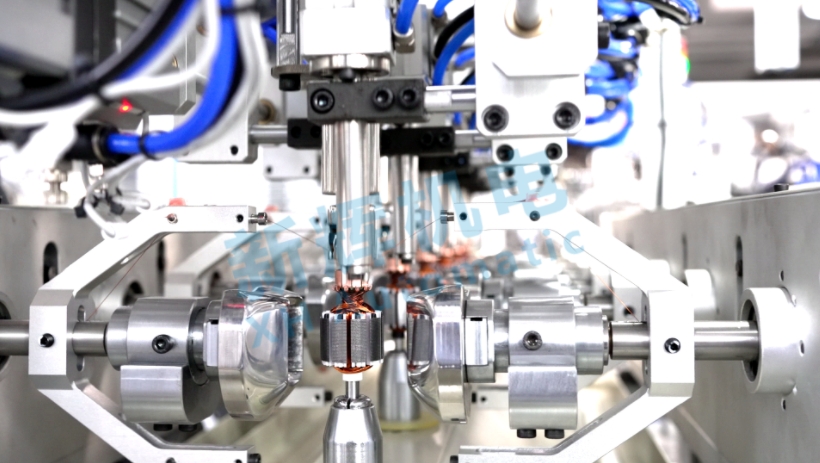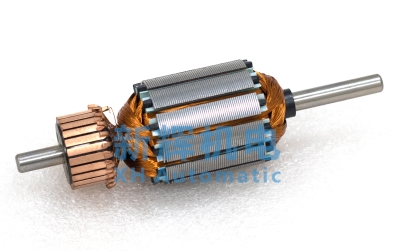Motor motor rotor automatic six-station double flying fork winding machine how to carry out maintenance?
Motor motor rotor automatic six-station double flying fork winding machine maintenance is essential to ensure the normal operation of the equipment, to extend the service life and ensure product quality. The following are detailed maintenance methods:
First, routine maintenance
1、Cleaning
Body cleaning: After each day's work, use a clean soft cloth to wipe the body of the winding machine to remove dust, oil and other debris. Pay special attention to cleaning key components such as the flying fork, clamps, guide rails and wire feeding mechanism, as these places are prone to accumulating dirt and affecting the normal operation of the equipment. For example, dust on the flying fork may enter the bearings and increase friction, resulting in poor fork movement.
Clean working environment: Keep the working area around the coil winder tidy and avoid accumulation of debris. This not only prevents foreign objects from entering the interior of the equipment, but also provides a comfortable working environment for the operator.

2、Mechanical parts inspection
Transmission parts inspection: check the status of transmission parts such as belts, chains and gears. Check whether the belt is slack, worn or cracked; whether the links of the chain are loose, falling off or badly worn; whether the teeth of the gear are worn, missing teeth or poorly occluded. If found, they should be adjusted or replaced in time. For example, if the belt is slack, the proper tension can be restored by adjusting the tensioning wheel.
Flying Fork and Fixture Inspection: Check whether the movement of the flying fork is smooth, and whether there are any abnormal noises or looseness in the rotating shaft and bearings of the flying fork. For the fixture, make sure the collet can firmly clamp the rotor and the opening and closing action is flexible. If the collet is found to be worn, it should be replaced in time to ensure the stability of the rotor in the winding process.
Guide rail and slider inspection: Check whether the surface of the guide rail is flat and smooth, with no scratches or wear. The slider should be able to slide freely on the guide rail without jamming. If necessary, clean the guide rail and slider, and add appropriate amount of grease to reduce friction.
3、Electrical system check
Connection line check: Check all electrical connection lines, including power lines, signal lines, sensor lines, etc., to see if there are signs of looseness, breakage or aging. Ensure that the plugs and sockets are firmly connected, and if they are loose, they should be plugged in tightly; for broken or aging wires, they must be replaced to prevent failures such as short circuits or broken circuits.
Electrical component inspection: Observe the working condition of electrical components such as motor, driver, sensor and controller. Check whether the motor has abnormal heat, vibration or noise; whether the indicator light of the driver is normal; whether the sensor is loose or damaged; whether the display of the controller is clear and whether the buttons are sensitive. If abnormalities are found, the relevant components should be further checked or replaced.
Second, regular maintenance (weekly or monthly)
1、Mechanical components in-depth maintenance
Transmission components maintenance: every once in a while, more in-depth maintenance of transmission components. For the belt, in addition to checking the tension, it can be maintained with a special belt maintenance agent to extend the life of the belt. Chains can be removed for cleaning and then soaked in lubricant to make them fully lubricated before re-installation. Gears, on the other hand, need to be regularly cleaned of oil and impurities on the tooth surface, check whether there are fatigue cracks on the tooth roots, and add the right amount of gear oil.
Flying Fork and Fixture Maintenance: Remove the protective cover of the flying fork periodically to inspect the internal rotor shaft, bearings and other mechanical structures. If the bearings are badly worn, they should be replaced and the precision of the flying fork should be readjusted. For fixtures, in addition to replacing worn out collets, check the wear and tear of the mechanical transmission parts of the fixtures, such as connecting rods, cams and other parts, and repair or replace them if necessary.
Lubrication system maintenance: Check the lubrication system of the equipment, including oil cups, oil pipes and lubrication pumps. Ensure that the lubrication system can work properly and that the oil is sufficient and clean. According to the manual of the equipment, replace the lubricating oil or grease regularly to ensure that all moving parts are well lubricated.
2, the depth of the electrical system maintenance
Electrical component cleaning and fastening: regularly clean the surface of the electrical components, remove dust and oil. For electrical components installed inside the equipment, such as circuit boards, etc., you can use compressed air canisters for blowing, but be careful to avoid damage to the components. At the same time, check whether the fixing screws of the electrical components are loose, if loose, they should be tightened in time to prevent the components from being damaged by vibration.
Sensor calibration and inspection: Regularly calibrate the sensor to ensure its measurement accuracy. For example, the tension sensor can be calibrated using standard weights, and the position sensor can be calibrated by precise positioning tools. Check whether the signal output of the sensors is normal or not, if there is any abnormality, it may be necessary to replace the sensors or adjust their installation position.
Control system software backup and update: Backup the software and parameter settings of the control system of the winding machine to prevent data loss. At the same time, check if there is an available updated version of the software, and if there is an update, follow the manufacturer's instructions for the update operation. Software updates can fix known software vulnerabilities and improve the performance and stability of the equipment.

Third, long-term maintenance (every six months or a year)
1、All mechanical parts overhaul
Mechanical structure inspection and repair: The entire mechanical structure of the winding machine is inspected in its entirety, including the frame of the body, the worktable, and the mechanical connection parts of each station. Check whether there is any deformation, crack or looseness, if there is any problem, it should be repaired or reinforced. For the problem of mechanical precision degradation after long-term use, such as the positional precision between each working station and the movement precision of the flying fork, etc., they can be detected by professional measuring tools and adjusted or repaired.
Replacement of key parts: According to the use time and wear and tear of the equipment, some key mechanical parts should be replaced preventively. For example, after a long time of operation, the rotor shaft of the flying fork may be fatigued and worn out, even if it has not yet failed, it can be considered to be replaced in order to avoid sudden failures in the production process.
2、Electrical system upgrading and remodeling
Electrical components update: With the continuous development of technology, some old electrical components may decline in performance or face discontinuation. In the long-term maintenance process, you can consider updating and upgrading some of the electrical components, such as replacing the motor with better performance, more advanced drive or high-precision sensors, in order to improve the overall performance of the equipment.
Control system upgrade: If the control system of the winding machine is relatively old, you can consider upgrading. For example, upgrade the old PLC control system to a more advanced model, or update all the control software to add new features, such as more accurate winding control algorithms, better human-computer interaction interface. This will not only improve production efficiency, but also improve product quality.
※ If you still can't solve the problem by the above ways and means, please contact the technical specialist of Xinhui Electromechanical Equipment Co., Ltd. through the page chat tool for help.








